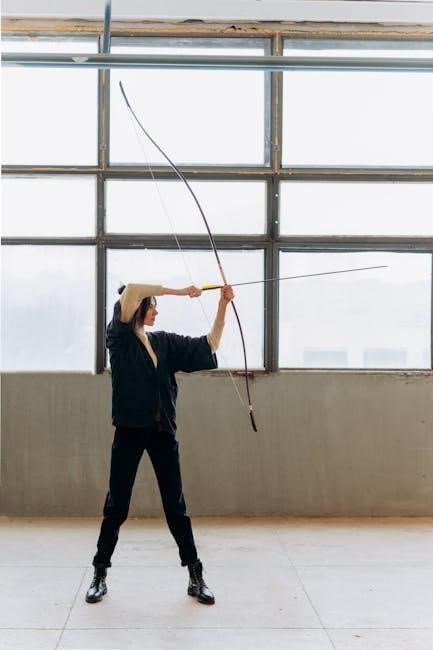Maxine Hong Kingston’s “The Woman Warrior”: An Overview
Maxine Hong Kingston’s The Woman Warrior‚ published in 1976‚ blends memoir and Chinese folklore. It explores cultural identity‚ gender roles‚ and the immigrant experience. Kingston narrates tales of influential women‚ detailing struggles and resilience within societal constraints.
Themes in “The Woman Warrior”
The Woman Warrior intricately weaves together several prominent themes. These include cultural identity‚ exploring the complexities of being Chinese-American‚ and gender roles. The power of storytelling emerges as a key element‚ shaping perceptions and preserving heritage‚ within the narrative.
Cultural Identity and Hybridity
The Woman Warrior delves deeply into the complexities of cultural identity‚ particularly the hybrid experience of Chinese-Americans. Maxine Hong Kingston explores the challenges of navigating between two distinct cultures: the traditional Chinese heritage passed down through “talk-stories” and the modern American environment in which she grows up. This creates a sense of “not belonging‚” a recurring theme represented by ghosts.
Kingston examines the tension between assimilation and cultural preservation‚ highlighting the struggle to reconcile conflicting values and expectations. The memoir showcases how individuals forge their identities by blending elements from both cultures‚ creating a unique hybridity that defies simple categorization. This exploration provides a nuanced perspective on the immigrant experience and the search for selfhood in a multicultural society. The book’s narrative structure itself reflects this hybridity‚ blending personal memoir with Chinese folklore.
Gender Roles and Expectations
The Woman Warrior critically examines the restrictive gender roles and expectations imposed on women within both Chinese and American cultures. Kingston contrasts the “talk-stories” of strong‚ wily women warriors with the real oppression faced by women in traditional Chinese society. The memoir highlights practices like foot-binding‚ which exemplify the patriarchal control over women’s bodies and lives.
Kingston also explores the challenges faced by women in America‚ where they are often marginalized and silenced. Through her own experiences and the stories of other women‚ Kingston reveals the struggle to break free from these constraints and assert their agency. The book challenges traditional notions of femininity and celebrates the resilience and strength of women who defy societal expectations. The narrative underscores the importance of female solidarity and the power of storytelling in empowering women to reclaim their voices.
The Power of Storytelling
In The Woman Warrior‚ storytelling emerges as a potent force‚ shaping identity‚ preserving cultural heritage‚ and challenging societal norms. Kingston utilizes her mother’s “talk-stories” – a blend of Chinese folklore and personal narratives – to explore her own experiences as a Chinese-American woman. These stories serve as a bridge between two worlds‚ connecting Kingston to her ancestral past while navigating her present reality.
Through storytelling‚ Kingston reclaims her voice and agency. She fills in the gaps and mystifying spaces in her mother’s stories with her own interpretations‚ engaging with her family’s past and forging her own identity. The act of narrating and rewriting these stories allows Kingston to confront trauma‚ challenge traditional narratives‚ and empower herself and other women. Storytelling becomes a tool for resistance‚ healing‚ and self-discovery.

Narrative Structure and Genre
The Woman Warrior defies simple categorization‚ blending memoir with folklore and fiction. Kingston’s narrative structure weaves together personal experiences and Chinese “talk-stories‚” blurring the lines between autobiography and myth‚ creating a unique literary form.
Blending Memoir and Folklore
Maxine Hong Kingston masterfully intertwines personal experiences with Chinese folklore in The Woman Warrior‚ creating a narrative tapestry that explores identity and heritage. The memoir’s structure blurs the lines between autobiography and myth‚ as Kingston weaves “talk-stories” from her mother into her own coming-of-age narrative. These tales‚ filled with powerful women and ancient traditions‚ serve as both a source of strength and a point of conflict for the young Kingston as she navigates her bicultural identity.
The blending of memoir and folklore allows Kingston to explore the complexities of her Chinese-American experience in a way that a traditional autobiography could not. By incorporating fantastical elements and mythical figures‚ she captures the essence of her cultural heritage while simultaneously challenging and reinterpreting it through a modern‚ feminist lens. This fusion gives voice to the unspoken tensions and unspoken realities of immigrant life.
Autobiographical Controversy
The Woman Warrior sparked significant debate regarding its classification as autobiography due to Kingston’s blending of fact and fiction. Critics questioned the accuracy of her portrayal of Chinese culture and traditions‚ leading to discussions about authenticity and representation. Some argued that Kingston’s creative license distorted the realities of the Chinese-American experience‚ while others defended her right to reimagine and reinterpret her heritage through a personal lens.
The controversy highlights the complexities of writing about cultural identity‚ particularly within the context of memoir. Kingston’s innovative approach challenged traditional notions of autobiography‚ raising questions about the role of memory‚ imagination‚ and cultural interpretation in shaping personal narratives. This debate continues to resonate‚ prompting ongoing discussions about the ethics and responsibilities of autobiographical writing.

Key Female Figures
The Woman Warrior presents compelling female figures. These include Fa Mu Lan‚ the mythical warrior‚ and Kingston’s mother‚ Brave Orchid. They serve as sources of strength‚ resilience‚ and cultural connection within Kingston’s narrative.
Fa Mu Lan: The Mythical Warrior
Fa Mu Lan‚ a central figure in The Woman Warrior‚ embodies female empowerment and challenges traditional gender roles. Kingston reimagines the legendary warrior‚ highlighting her strength‚ courage‚ and defiance against societal expectations. Fa Mu Lan’s story serves as an inspiration for Kingston‚ representing the potential for women to break free from constraints and achieve greatness.
Mu Lan’s mythical status allows Kingston to explore themes of identity and transformation. She embodies the fusion of Chinese folklore and personal narrative that defines the book. By embracing Mu Lan’s warrior spirit‚ Kingston grapples with her own cultural heritage and her desire for self-discovery. The tale empowers her to navigate the complexities of being a Chinese-American woman.
The warrior woman epitomizes resilience. She offers a potent symbol of resistance against oppression. Kingston uses the figure of Mu Lan to explore the power of storytelling. She also uses it to show the ways in which myths can shape individual identity and inspire collective action. Her story is a testament to the enduring strength and potential of women.
Kingston’s Mother: The Source of “Talk-Stories”
Kingston’s mother is pivotal‚ serving as the primary source of “talk-stories” that permeate The Woman Warrior. These stories‚ blending Chinese folklore and personal anecdotes‚ shape Kingston’s understanding of her heritage. They also shape her identity as a Chinese-American woman. Her mother’s narratives‚ though sometimes perplexing‚ provide a vital link to the past. They offer lessons about strength‚ resilience‚ and the challenges faced by women in both Chinese and American societies.
The “talk-stories” act as a bridge between cultures‚ transmitting values and traditions across generations. Kingston grapples with interpreting these stories. She also grapples with reconciling them with her own experiences in America. Her mother’s voice becomes a powerful force in her life. It influences her perception of gender roles‚ family loyalty‚ and the power of storytelling itself.
Through her mother’s tales‚ Kingston explores the complexities of female identity and the enduring impact of cultural heritage. The stories are a source of both inspiration and confusion. Ultimately‚ they are the foundation upon which she builds her own narrative;

Critical Perspectives
Critical analyses of The Woman Warrior often focus on feminist interpretations‚ exploring gender roles and expectations. Post-Jungian perspectives analyze Kingston’s reconciliation with her mother. Cultural identity and hybridity also form the basis of interpretations.
Feminist Interpretations
Feminist interpretations of The Woman Warrior examine how Kingston’s work challenges traditional gender roles and expectations within both Chinese and American cultures. Critics analyze how the text portrays the constraints placed upon women‚ exploring themes of female oppression and resilience. The “talk-stories” passed down from Kingston’s mother are viewed as a means of empowering women‚ offering alternative narratives that celebrate female strength and agency. The intersection of gender with cultural identity and the immigrant experience is also a central focus‚ highlighting the unique challenges faced by Chinese-American women. These readings often consider how Kingston reclaims and redefines female identity through her narrative‚ challenging patriarchal structures and promoting female solidarity and empowerment. The text serves as a powerful commentary on the complexities of womanhood across cultures.
Post-Jungian Analysis
A Post-Jungian analysis of The Woman Warrior delves into the psychological depths of Kingston’s narrative‚ focusing on her journey toward self-discovery and reconciliation with her mother. This perspective views the memoir as an unconscious reprocessing of Kingston’s relationship with her maternal figure‚ examining how she integrates her “shadow” and embraces her feminine nature. The “talk-stories” become symbolic of the mother complex‚ representing a psychological impasse that Kingston confronts through writing. By translating and rewriting these stories‚ she navigates her inner world‚ breaking down barriers and achieving a greater understanding of herself. The randomness of the narrative structure aligns with the unconscious nature of this process‚ revealing how Kingston’s psyche drives her creative expression and ultimately fosters healing and wholeness.